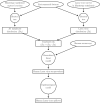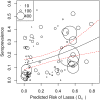Bridging the gap: Using reservoir ecology and human serosurveys to estimate Lassa virus spillover in West Africa
- PMID: 33657095
- PMCID: PMC7959400
- DOI: 10.1371/journal.pcbi.1008811
Bridging the gap: Using reservoir ecology and human serosurveys to estimate Lassa virus spillover in West Africa
Abstract
Forecasting the risk of pathogen spillover from reservoir populations of wild or domestic animals is essential for the effective deployment of interventions such as wildlife vaccination or culling. Due to the sporadic nature of spillover events and limited availability of data, developing and validating robust, spatially explicit, predictions is challenging. Recent efforts have begun to make progress in this direction by capitalizing on machine learning methodologies. An important weakness of existing approaches, however, is that they generally rely on combining human and reservoir infection data during the training process and thus conflate risk attributable to the prevalence of the pathogen in the reservoir population with the risk attributed to the realized rate of spillover into the human population. Because effective planning of interventions requires that these components of risk be disentangled, we developed a multi-layer machine learning framework that separates these processes. Our approach begins by training models to predict the geographic range of the primary reservoir and the subset of this range in which the pathogen occurs. The spillover risk predicted by the product of these reservoir specific models is then fit to data on realized patterns of historical spillover into the human population. The result is a geographically specific spillover risk forecast that can be easily decomposed and used to guide effective intervention. Applying our method to Lassa virus, a zoonotic pathogen that regularly spills over into the human population across West Africa, results in a model that explains a modest but statistically significant portion of geographic variation in historical patterns of spillover. When combined with a mechanistic mathematical model of infection dynamics, our spillover risk model predicts that 897,700 humans are infected by Lassa virus each year across West Africa, with Nigeria accounting for more than half of these human infections.
Conflict of interest statement
The authors have declared that no competing interests exist.
Figures






References
Publication types
MeSH terms
Grants and funding
LinkOut - more resources
Full Text Sources
Other Literature Sources
Miscellaneous

